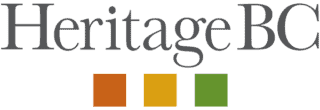- Heritage 101
- Advocacy
- Accessibility for Historic Places
- Climate & Sustainability
- Cultural Maps
- Heritage Place Conservation
- Heritage Policy & Legislation
- Homeowners
- Intangible Cultural Heritage
- Reconciliation
- Indigenous Cultural Heritage
- Setting the Bar: A Reconciliation Guide for Heritage
- 1. Heritage and Reconciliation Pledge
- 2. Acknowledging Land and People
- 3. Celebrating Days of Recognition and Commemoration
- 4. With a Commitment to Learn
- 5. Committing to Strategic Organizational Diversity
- 6. Mission-Making Room for Reconciliation
- 7. Possession, Interpretation, Repatriation and Cultural Care
- 8. Shared Decision Making
- 9. Statements of Significance and other heritage planning documents
- 10. Heritage Conservation Tools, Local Government Act
- Racism: Do Not Let the Forgetting Prevail
- Taking Action: resources for diversity and inclusion
- Webinars On-Demand
Community Heritage Register: Process
 Heritage Conservation: A Community Guide (1995) and Establishing Community Heritage Registers offer step-by-step guidance to establishing and maintaining a Community Heritage Register (CHR).
Heritage Conservation: A Community Guide (1995) and Establishing Community Heritage Registers offer step-by-step guidance to establishing and maintaining a Community Heritage Register (CHR).
A CHR is a cornerstone to a local government’s community heritage program. It should be implemented as part of a carefully planned heritage program to achieve clearly stated community goals.
- Through a process of planning and research, community heritage issues and needs are assessed and a vision for the community’s heritage resources is developed. This process will support the identification of heritage values, which are used to establish identification criteria.
- The local government establishes eligibility criteria for the CHR. See Criteria in this guide for more information.
- Community heritage resources are researched and identified. Obtain or develop the required documentation; this includes Statements of Significance for each property.
- A preliminary Community Heritage Register list of resources is created by local government staff, members of the community heritage commission, or by a group appointed by a city council or local government. Review the list to ensure it reflects the community’s heritage values.
- The local government consults with property owners (explanatory letters followed by personal meetings) and anticipates the continuing need to provide information and to raise awareness, by such means as:
-
- preparing clear and simple information packages (communities may wish to explain that registry status is not the same as designation status);
- preparing a map of heritage properties;
- assembling available information (such as before and after restoration photos, maps, archival material, inventories, etc.);
- holding review meetings or workshops;
- explaining eligibility criteria for financial assistance for conservation; and/or
- offering technical assistance (e.g., design advice or rehabilitation standards).
- The local government reviews, and, if necessary, revises the proposed Community Heritage Register.
- By resolution, a council or regional district board establishes or adds to a Community Heritage Register. See Recommendations and Resolution for more information.
- Develop a database of CHR records and/or post list of records on website.
- Within 30 days of including a property on the heritage register, the local government will provide notice to the Heritage Branch for inclusion on the BC Register of Historic Places. Historic places that are fully documented, including a Statement of Significance, are added to the Canadian Register of Historic Places by the BC Registrar at the Heritage Branch.
- Regularly maintain, review, and add to the CHR. Properties may be added to, or deleted from, the Community Heritage Register by resolution of the council or regional district board.
Heritage Conservation: A Community Guide provides two scenarios:
Scenario 1
A community undertakes a process of planning in its downtown commercial core which identifies five individual buildings of heritage value to the community. Three of the buildings are privately owned. The local government consults with the property owners, who are advised that no legal protection will result from inclusion on the register but that their properties will be flagged on the local government’s property file system. The local government a) passes a resolution which establishes the register, and, b) notifies both the property owners and the minister responsible for heritage conservation.
Scenario 2
A local government plans to draft a local area plan for a residential neighbourhood. As a part of the planning process it decides to establish a Community Heritage Register for the neighbourhood. The research is completed, and residents and property owners are invited to a meeting to discuss the proposed register. Following the meeting, where most of the residents indicate their support for the register, council passes a resolution to establish the register and notifies the property owners and the minister responsible for heritage conservation.
Heritage Conservation, A Technical Guide for Local Governments includes the following advice for establishing a CHR:
- Ideally, a community heritage register is implemented comprehensively; realistically, it is implemented incrementally. If a community has a number of neighbourhoods or development permit zones, it can implement a register for each zone during the creation or revision of the neighbourhood plan.
- Inform the council or regional district early in the process about the meaning and potential benefits of a community heritage register.
- Educate the general public early in the process about the benefits of a community heritage register.
- Consult with property owners prior to the inclusion of their properties in a register, even though the legislation does not require this action. If consultation does not occur, the political ramifications could be disastrous.
- Encourage council to offer financial incentives for those who agree to have their property registered. These incentives should facilitate public acceptance
- Create other incentives, such as the fast-tracking of development permit applications, relaxation of parking regulations, zoning relaxations, etc.
- Be aware that an extensive list of prospective properties being recommended at the same time for inclusion in a register may each require lengthy discussions with owners and council. Allow enough time because this process may be a slow one.
- Compile a manageable list of properties with a guarantee of success. Cooperative property owners and popular sites can help establish a successful track record.
- For the first list of registered properties, concentrate on the same kinds of buildings, such as churches or houses, etc. Promote common heritage characteristics. Encourage the council to lead the way by registering all of the valued municipally-owned buildings.
- It is important that a register be carried out in concert with a neighbourhood plan or other land use plans (density, zoning, land use). Planning tools should not send different messages to the community and the developers. For example, do not expect to protect single-family heritage homes by including them in a community heritage register if the zoning for that neighbourhood allows for high-density development.
